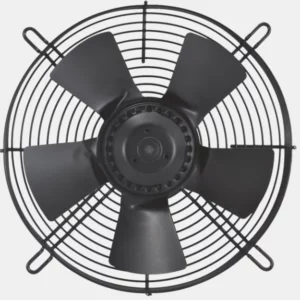Several future trends and advancements are anticipated in AC axial fan technology and applications:
- Efficiency Improvements: Continued focus on enhancing the efficiency of AC axial fans to meet evolving energy efficiency regulations and sustainability goals. Advancements in motor design, aerodynamics, materials, and manufacturing processes aim to achieve higher airflow performance with reduced energy consumption and lower operating costs.
- Smart Fan Technology: Integration of smart features and connectivity options into AC axial fans, allowing for remote monitoring, control, and optimization of fan performance. Smart fan technology enables predictive maintenance, fault diagnostics, and real-time adjustments based on environmental conditions, usage patterns, and system requirements, enhancing reliability and efficiency.
- Variable-Speed Drives (VSDs): Increasing adoption of variable-speed drives (VSDs) or frequency converters with AC axial fans to enable precise speed control and modulation of airflow rates. VSDs optimize fan operation by adjusting motor speed according to demand, reducing energy consumption, noise levels, and wear on fan components while maintaining optimal ventilation performance.
- Advanced Materials: Development of lightweight, high-strength materials and composite structures for fan blades, housings, and impellers to improve efficiency, durability, and corrosion resistance. Advanced materials offer opportunities for weight reduction, noise reduction, and thermal management, enabling more compact and efficient fan designs.
- Noise Reduction Technologies: Integration of noise reduction technologies, such as aerodynamic blade profiles, sound-absorbing materials, and vibration damping mechanisms, to minimize noise emissions and improve acoustic comfort in indoor environments. Quiet operation is increasingly important for applications where noise levels must be kept to a minimum, such as HVAC systems in residential, commercial, and healthcare facilities.
- Air Quality Monitoring: Integration of air quality sensors and particulate matter detectors into AC axial fan systems to provide real-time monitoring of indoor air quality parameters, such as pollutant levels, humidity, and temperature. Fan operation can be adjusted dynamically based on air quality data to optimize ventilation effectiveness and maintain healthy indoor environments.
- Modular and Customizable Designs: Development of modular fan designs and customizable configurations to accommodate diverse application requirements, space constraints, and installation preferences. Modular fan systems allow for easier installation, maintenance, and scalability, while customizable options enable tailored solutions for specific ventilation needs and building layouts.
- Energy Recovery Ventilation (ERV): Integration of energy recovery ventilation systems with AC axial fans to capture and recirculate waste heat or cool air from exhaust air streams, improving energy efficiency and indoor comfort. ERV systems exchange heat or moisture between incoming and outgoing air streams, reducing the load on heating and cooling equipment and lowering energy consumption.
- Green Building Standards: Alignment of AC axial fan technology with green building standards, such as LEED (Leadership in Energy and Environmental Design) and BREEAM (Building Research Establishment Environmental Assessment Method), to promote sustainable building practices and certification. Energy-efficient fan systems contribute to green building credits and help achieve energy performance targets for sustainable construction projects.
- Integration with Building Automation Systems: Seamless integration of AC axial fan systems with building automation and control systems (BACS) to enable centralized monitoring, scheduling, and optimization of HVAC operations. Interoperability with BACS platforms facilitates energy management, occupant comfort control, and predictive maintenance strategies, maximizing the efficiency and performance of building ventilation systems.
Overall, these future trends and advancements in AC axial fan technology and applications aim to enhance energy efficiency, reliability, comfort, and environmental sustainability in various residential, commercial, industrial, and institutional settings where ventilation and air movement are essential.
